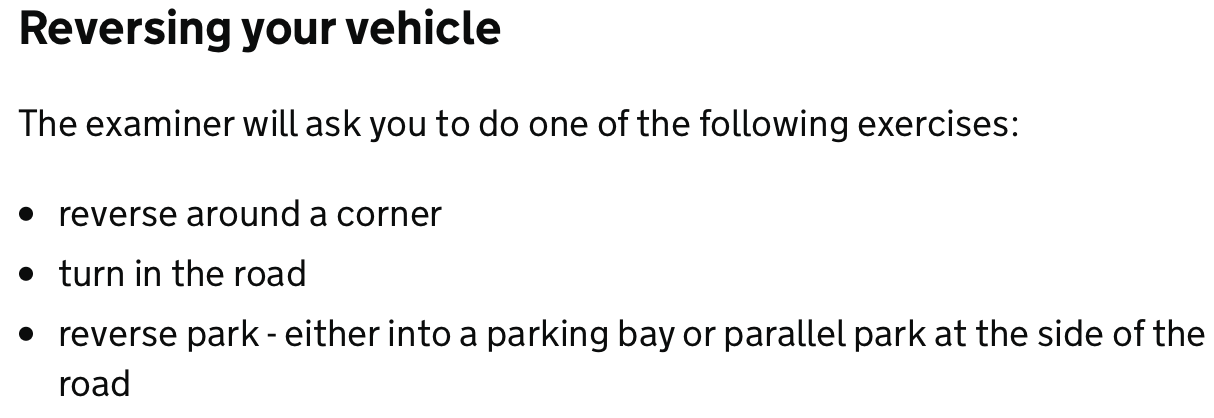How do you do Parallel Parking
Parallel Parking is renowned to be the most difficult manoeuvre out of the four manoeuvres for new drivers. No - for any driver even after their test actually, this remains the toughest manoeuvre to most.

- Image from GOV.UK
Unfortunately, there’s a strong possibility that it could come up in your driving test too. But, there’s a good reason for this – parallel parking allows you to get into small spaces which you wouldn’t be able to get into otherwise. So parallel parking isn’t a skill you need to only learn purely to pass your test, it is a skill which is going to be incredibly useful throughout your life as a motorist.
Parallel parking isn’t actually hard once you've done it several times, but it might be scary if you are new, or trying to do it correctly for a driving test. Thankfully, we are going to provide you with a simple, incremental breakdown of how to parallel park perfectly each and every time. Our guide will enable you to feel more comfortable when performing a parallel park during your driving test and in your everyday life afterwards.

What is the instructor looking for whilst parallel parking (reverse parking)?
Firstly, students should realise that the examiner isn't an alien. They want you to pass too. Remember to try to stay composed, they expect you to make mistakes - not many people don't. The main things they will be looking for during a parallel park are:
How accurate you are - Yes, if you finish the reverse park on a street on the other side of the country, chances are - you'll probably fail.
Clutch control - Clutch control is important in every aspect of learning to drive. Especially with parallel parking.
Checking your surroundings - As your instructor probably always tells you - MIRRORS, blind spots, just having a good awareness of what is around you.
How do you reverse park? [STEPS]
-
Look for a parking space with a suitable amount of space.
-
Make yourself level with the car in front of the space you have found. It doesn’t matter how big your car is – make sure the boot of your car is level with the boot of the car in front.
-
HALT – Check your surroundings, if it is safe to do so – move onto 4).
-
Whilst idle, turn the wheel all the way to the left. Remember to stay idle whilst doing this.
-
Put your clutch pedal down and get into your reverse gear. Look over your other shoulder so you can see out of the rear of your car.
-
Begin reversing SLOWLY. Gentle clutch control is crucial here. The car will now start moving into the space of your choice. Make sure the wheel remains fully turned whilst doing this process.
-
Stop reversing when the left-front corner of the back of the car is in the central of your rear window. If you have a more mathematical brain, in other words, reverse until the car is at a 45-degree angle.
-
HALT. (I would say stop… but I’m enjoying the whole halt thing too much, so I apologise).
-
Whilst idle, turn the wheel right back to the middle.
-
Using gentle clutch control, reverse slowly until the car slightly goes past the car in front, and then HALT again.
-
HALTTTTT.
-
Move the wheel completely to the right. COMPLETELY RIGHT! Stay idle whilst turning the wheel.
-
Keep reversing. DON’T MOVE THE WHEEL FROM THIS POSITION AT ALL!
-
Once the car is straight, STOP and make the wheel central.
|
Now, if you followed these instructions, you should be parallel to the car in front, in the space. If not, it’s no big deal. Just indicate to show that you are about to move out of the position you landed in. Drive out next to the car in front of you, indicate to the designated space again, and do it again. Lots of people struggle with this manoeuvre – so you aren’t alone. Ultimately, practice makes perfect. Keep practising your parallel parking and you will get it right eventually.
The perfect distance when performing a parallel park, is probably to be within three inches of the curb. If you are further away than this – Don’t worry. Try again – You will get the grasp of parallel parking eventually. We promise.
Reverse Parking Tips
Good clutch control. Don't feel rushed, keep calm and your driving will reflect this. Keep the car extremely slow.
Follow your reference points religiously. If you follow them, you can't fail. If you go wrong, then take a breathe and start again.
Always be aware of your surroundings. When reversing, it's easy to take your mind off the number one rule - which is safety.
If you make an error during a driving test - don't be scared to ask to do it again. If anything, the examiner will be impressed. If you make an error in your lessons, then practice, practice and practice.
Is this the only technique I can use?
No. There is a number of trusted techniques. All of them have similarities though - and this is sticking to their reference points. If this article doesn't float your boat, then have a look for different techniques. There is plenty to choose from.
This is another parallel parking technique called the '1:2:1 method' courtesy of World Driving. This is a great method, it has also been taught to perfection - mainly because of the simple but effective parallel parking reference points. The video also shows you how to fix an error during the reverse park. This is another technique you could try!
Does it matter which parallel parking technique I use?
It doesn't matter which technique you use. It's what works best for you, if your driving instructor has suggested a different parallel parking technique - and you feel comfortable with it, then stick with it! No way is the right way. On the other hand, if the other technique for parallel parking isn't working for you - give our reverse parking technique a try instead.